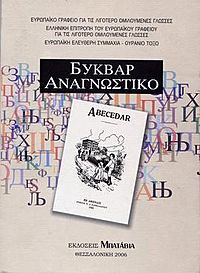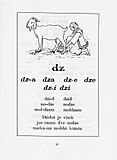Abecedar facts for kids

The first page of the Abecedar published in 2006 in Thessaloníki.
|
|
| Country | Greece |
|---|---|
| Language | Lerin dialect (1925 edition) Macedonian, Greek, English (2006 edition) |
| Publisher | Batavia, Thessaloniki |
|
Publication date
|
1925/2006 |
| Media type | Paperback |
| Pages | 96 (1925 edition) |
| ISBN | 960-89330-0-5 (2006 edition) |
| OCLC | 317448359 |
- Note: "Abecedar" is also the name of the primer (1st grade school book) in Romanian.
The Abecedar was a special school book first printed in Athens, Greece in 1925. It was made for children who spoke a Slavic language in the Lerin region of Greece. This book became quite famous because of a disagreement between Greece and its neighbors, Bulgaria and Serbia.
Greece said the book proved it was helping its Slavic-speaking people. However, Bulgaria and Serbia had concerns. The book used the Latin alphabet, not the Cyrillic alphabet which is common for Slavic languages in the southern Balkans. Today, the Abecedar is published in Standard Macedonian, Standard Greek, and Standard English.
Contents
Later Editions of the Abecedar
The Abecedar has been printed again two times since its first release.
The 1993 Edition
In 1993, a new version was published. This edition came out in Perth, Western Australia. It was put together by the Macedonian Information Center.
The 2006 Edition
Another edition was published in 2006. This one came out in Thessaloníki, Greece. It was started by a political group called Rainbow. This newest book includes the original text in the Macedonian language. It also has translations in Greek and English. The 2006 edition also shares information about how people reacted to the very first book and its history. The Rainbow group believes the Abecedar is an important document. They say it shows that "Macedonian" was seen as different from "Greek" by official Greek documents long before 1945.
How the Abecedar Works
The first Abecedar book was based on the Bitola-Florina dialect. Most of the words in the book came from this specific way of speaking.
Latin Alphabet Use
A key feature of the Abecedar is that it uses the Latin alphabet. This is different from the Macedonian alphabet. The Macedonian alphabet uses the Cyrillic alphabet and was officially set up almost 20 years later. Interestingly, the standard Macedonian alphabet was also based on the same dialect.
Unique Letters
The alphabet in the Abecedar has 27 different letters. Two of these letters are special. They represent sounds that are not found in the modern Macedonian alphabet. These are:
- Îî (for a short, unclear vowel sound, like the 'a' in 'about')
- Üü (which means the sound before it is softened, like the 'ny' in 'canyon')
The alphabet also uses combinations of two letters, called digraphs. These include gj, kj, nj, lj, and dz. They stand for sounds that match certain letters in the Macedonian alphabet. For example, gj is like Ѓ, kj is like Ќ, nj is like Њ, lj is like Љ, and dz is like Ѕ.
Alphabet Chart
Here is the alphabet used in the Abecedar with their IPA equivalents:
| А |
B |
C |
Č |
D |
E |
F |
G |
H |
| I |
Î |
J |
K |
L |
M |
N |
O |
P |
| R |
S |
Š |
T |
U |
Ü |
V |
Z |
Ž |
Grammar and Examples
The book also has a section that teaches grammar rules. All the learning material is supported by texts. These texts are taken from or inspired by the daily lives of people. This helps students understand and learn better. In the second edition of the book, explanations and texts were also written using the Macedonian Cyrillic alphabet.
Here are some examples from the second edition of the book:
- Našata kukja je visoka ("Our house is tall"). In modern Macedonian, this is našata kuḱa e visoka, written as нашата куќа е висока.
- Gjorče et edno arno dete ("Gjorče is one good child"). In modern Macedonian, this is Ǵorče e edno arno dete, written as Ѓорче е едно арно дете.
- Moite brakja set vo čusdžina [sic] ("My brothers are abroad"). In modern Macedonian, this is moite braḱa se vo tuǵina, written as моите браќа се во туѓина.
Gallery
-
Page for the digraph dz (Ѕ in Macedonian)




